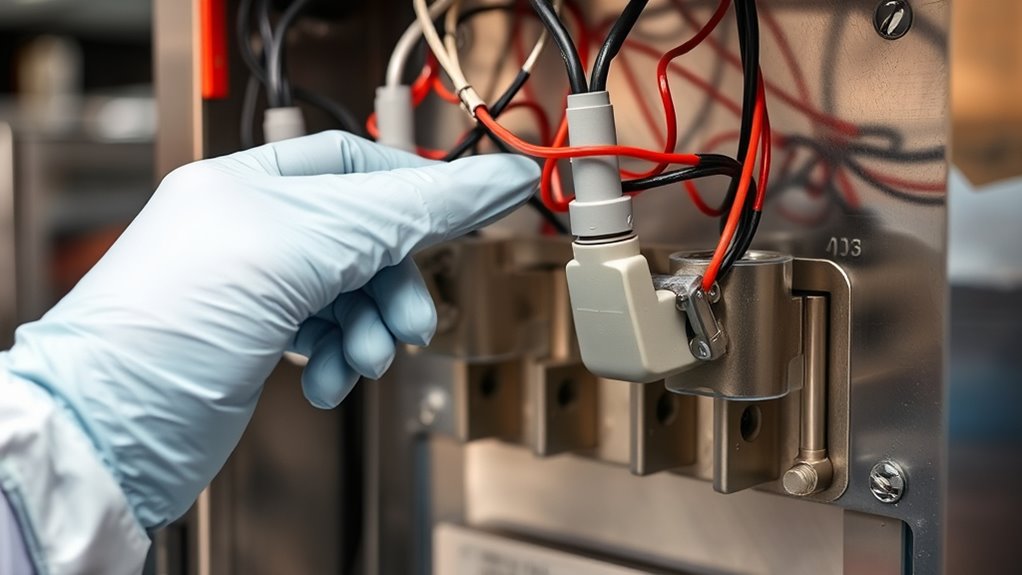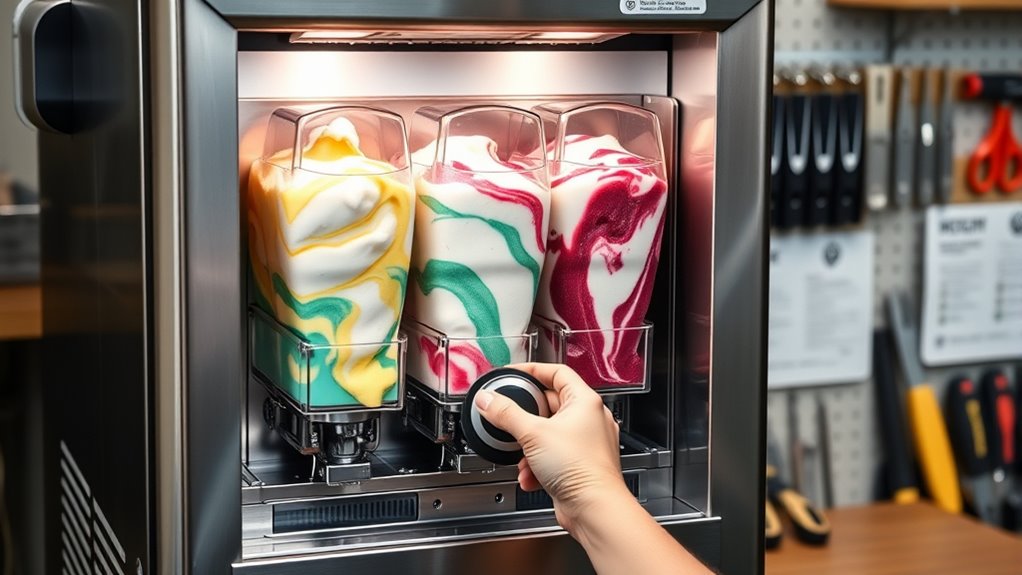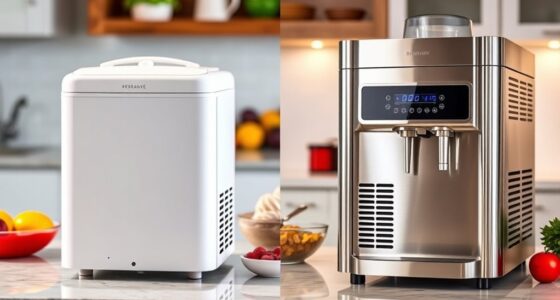If your ice cream machine isn’t working right, start by cleaning and inspecting key parts like paddles, bowls, and filters to remove any buildup. Check the temperature calibration and make sure the refrigeration system is functioning properly to prevent inconsistent freezing. Sometimes, restarting or tightening components can solve operational glitches. Regular maintenance helps avoid future problems, and staying on top of equipment checks keeps everything running smoothly. For detailed fixes, continue exploring effective troubleshooting steps that can save time and keep your production on track.
Key Takeaways
- Regularly clean and inspect freezer components to prevent cooling issues and ensure even freezing.
- Verify ingredient temperatures and quality to avoid texture problems like grit or ice crystals.
- Check and calibrate the machine’s temperature settings for consistent freezing performance.
- Monitor churning speed and duration to achieve smooth, uniform ice cream without over- or under-processing.
- Perform routine maintenance, including filter checks and equipment cleaning, to prevent common operational problems.

When your ice cream machine isn’t working properly, it can quickly turn a fun treat into a frustrating experience. The last thing you want is to see your batch turn soupy or icy because of preventable issues. One common cause for these problems is neglecting proper freezer maintenance. Regularly cleaning and inspecting your machine’s freezer components ensures that the temperature stays consistent and prevents ice buildup. If the freezer isn’t functioning correctly, your ice cream won’t freeze evenly, leading to inconsistent texture and flavor. Make sure the freezer coils are clean and unobstructed, and verify that the door seals tightly to maintain ideal temperature. Keeping the freezer in good shape helps avoid fluctuations that compromise ingredient consistency, which is essential for smooth, creamy ice cream.
Another key point is ingredient consistency. When your ingredients aren’t measured and mixed properly, it can throw off the freezing process or cause uneven texture. Always use precise measurements and follow your recipe closely. If your ingredients are too warm or too cold, or if the mixture isn’t blended thoroughly, it can affect how well the ice cream freezes and how smooth it turns out. Proper ingredient temperature before pouring into the machine helps the freezing process go smoothly. Additionally, ensure your ingredients are fresh and of high quality, as stale or inconsistent ingredients can cause the texture to turn gritty or overly icy. When your mix is consistent and well-prepared, the machine can work more efficiently, creating a uniform product. Proper paint sprayer maintenance and regular filter checks can also help keep your equipment running smoothly, preventing issues that could affect the freezing or mixing process. Regularly checking your cooling system can prevent temperature fluctuations that disrupt the ice cream’s texture. If you’re experiencing issues with the consistency of your ice cream, consider the speed and duration of your churning process as well. Overworking the mixture can introduce air, making it too fluffy, while under-churning can leave it dense. Adjust the churning time based on your recipe and the machine’s specifications. Sometimes, a simple restart or a quick cleaning of the paddle and bowl can resolve issues that seem complex. Additionally, understanding the importance of temperature calibration can help address problems related to inconsistent freezing performance. Proper regular maintenance can also prevent common issues before they arise, saving time and effort. Furthermore, staying informed about advancements in automation technology can help optimize your ice cream production process and prevent avoidable errors.
Frequently Asked Questions
How Often Should I Perform Maintenance on My Ice Cream Machine?
You should perform routine checks on your ice cream machine at least once a month to guarantee top performance. Regular maintenance helps you spot issues early, so you can replace worn parts before they cause problems. Keep an eye on the machine’s components and replace parts as needed. Consistent upkeep not only extends the lifespan of your equipment but also guarantees smooth operation and delicious ice cream every time.
What Is the Average Lifespan of an Ice Cream Machine?
The average lifespan of an ice cream machine varies based on machine durability and usage. Typically, you can expect it to last around 5 to 10 years. Factors like proper maintenance, frequency of use, and quality influence its lifespan. To maximize longevity, follow routine cleaning and service guidelines. Investing in a durable model and caring for it well guarantees you get the most out of your machine over the years.
Can I Troubleshoot Electrical Issues Myself Safely?
They say “safety first,” and that’s especially true with electrical issues. You can troubleshoot basics like unplugging the machine before inspecting circuits or resetting breakers, but always prioritize electrical safety. If you’re unsure or uncomfortable, don’t push your luck—call a professional. Remember, while troubleshooting can seem straightforward, electrical problems can be tricky and dangerous. Stay cautious, follow safety guidelines, and avoid risking injury or damage.
Are There Specific Cleaning Products Recommended for These Machines?
You ask about cleaning products for ice cream machines. It’s best to use cleaning solutions specifically designed for food equipment, as they’re safe and effective. Look for sanitizing agents approved for dairy machines to ensure proper hygiene. Avoid harsh chemicals that could damage parts or contaminate the product. Always follow the manufacturer’s instructions for dilution and contact time to maintain your machine clean and safe for use.
How Do I Prevent Ice Buildup Inside the Machine?
To prevent ice buildup inside your machine, you should follow proper storage tips and humidity control. Keep the machine in a cool, dry place, and regularly clean the air vents to reduce moisture. Make sure to turn off and unplug the machine when not in use, especially during off-seasons. This helps maintain ideal humidity levels, preventing excess condensation and ice formation, ensuring smoother operation and longer-lasting performance.
Conclusion
Don’t let small hiccups spoil your frozen delights. With a little patience and these simple steps, you’ll soon be back to enjoying creamy, dreamy ice cream. Think of it as giving your machine a gentle tune-up—kind of like a quick spa day for your appliance. Before you know it, you’ll be savoring perfect scoops again. So, keep calm and carry on fixing; your sweet treat awaits just around the corner!








